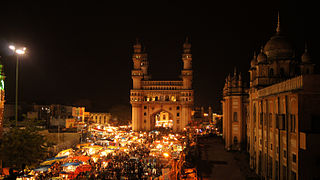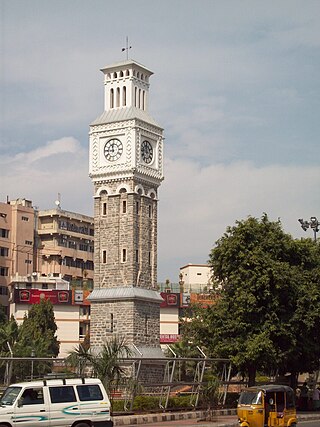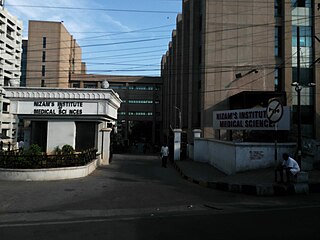
Hyderabad is the capital and largest city of the Indian state of Telangana. It occupies 650 km2 (250 sq mi) on the Deccan Plateau along the banks of the Musi River, in the northern part of Southern India. With an average altitude of 542 m (1,778 ft), much of Hyderabad is situated on hilly terrain around artificial lakes, including the Hussain Sagar lake, predating the city's founding, in the north of the city centre. According to the 2011 census of India, Hyderabad is the fourth-most populous city in India with a population of 6.9 million residents within the city limits, and has a population of 9.7 million residents in the metropolitan region, making it the sixth-most populous metropolitan area in India. With an output of US$ 95 billion, Hyderabad has the sixth-largest urban economy in India.

Osmania University is a collegiate public state university located in Hyderabad, Telangana, India. Mir Osman Ali Khan, the 7th Nizam of Hyderabad, issued a firman calling for its creation on 29 August 1917. It is the third oldest university in southern India, and the first to be established in the erstwhile Kingdom of Hyderabad. It was the first Indian university to use Urdu as a language of instruction, although with English as a compulsory subject. As of 2012, the university hosts 3,700 international students from more than 80 nations.

Hyderabad State was a princely state in the south-central Deccan region of India with its capital at the city of Hyderabad. It is now divided into the present-day state of Telangana, the Kalyana-Karnataka region of Karnataka, and the Marathwada region of Maharashtra in India.

A vocational school, trade school, or technical school is a type of educational institution, which, depending on the country, may refer to either secondary or post-secondary education designed to provide vocational education or technical skills required to complete the tasks of a particular and specific job. In the case of secondary education, these schools differ from academic high schools which usually prepare students who aim to pursue tertiary education, rather than enter directly into the workforce. With regard to post-secondary education, vocational schools are traditionally distinguished from four-year colleges by their focus on job-specific training to students who are typically bound for one of the skilled trades, rather than providing academic training for students pursuing careers in a professional discipline. While many schools have largely adhered to this convention, the purely vocational focus of other trade schools began to shift in the 1990s "toward a broader preparation that develops the academic" as well as the technical skills of their students.

Nizam of Hyderabad was the title of the ruler of Hyderabad State. Nizam is a shortened form of Niẓām ul-Mulk, and was the title bestowed upon Asaf Jah I when he was appointed Viceroy of the Deccan by the Mughal Emperor Farrukhsiyar. In addition to being the Mughal Viceroy (Naib) of the Deccan, Asaf Jah I was also the premier courtier of the Mughal Empire until 1724, when he established an independent realm based in Hyderabad, but in practice, continued to recognise the nominal authority of emperor.

Secunderabad is a twin city of Hyderabad and one of the six zones of the Greater Hyderabad Municipal Corporation (GHMC) in the Indian state of Telangana. It is the headquarters of the South Central Railway zone. Named after the Mir Akbar Ali Khan Sikander Jah, Asaf Jah III, Nizam of the Asaf Jahi dynasty, Secunderabad was established in 1806 as a British cantonment. Although both the cities are together referred to as the twin cities, Hyderabad and Secunderabad have different histories and cultures, with Secunderabad having developed directly under British rule until 1948, and Hyderabad as the capital of the Nizams' princely state of Hyderabad. Since 1956, the city has housed the Rashtrapati Nilayam, the winter office of the president of India. It is also the headquarter of the 54th Infantry Division of the Indian Army.

Asaf Jah VI, also known as Sir Mir Mahboob Ali Khan Siddiqi, was the sixth Nizam of Hyderabad. He ruled Hyderabad State, one of the princely states of India, between 1869 and 1911.

Mir Osman Ali Khan, Asaf Jah VII was the last Nizam (ruler) of Hyderabad State, the largest state in the erstwhile Indian Empire. He ascended the throne on 29 August 1911, at the age of 25 and ruled the State of Hyderabad between 1911 and 1948, until the Indian Union annexed it. He was styled as His Exalted Highness (H.E.H) the Nizam of Hyderabad, and was widely considered one of the world's wealthiest people of all time. With some estimates placing his wealth at 2% of U.S. GDP, his portrait was on the cover of Time magazine in 1937. As a semi-autonomous monarch, he had his mint, printing his currency, the Hyderabadi rupee, and had a private treasury that was said to contain £100 million in gold and silver bullion, and a further £400 million of jewels. The major source of his wealth was the Golconda mines, the only supplier of diamonds in the world at that time. Among them was the Jacob Diamond, valued at some £50 million, and used by the Nizam as a paperweight.

Begumpet Airport is an airport that serves Hyderabad in Telangana, India. It is located in Begumpet and caters to general and military aviation. The airport is home to the Begumpet Air Force Station of the Indian Air Force. Begumpet was built by the Princely State of Hyderabad in the 1930s and served as the city's commercial airport for several decades. It eventually became overcrowded, with little room for expansion. After the opening of Rajiv Gandhi International Airport in Shamshabad on 23 March 2008, Begumpet ceased all commercial operations.

The Nizam College is a constituent college of Osmania University established in 1887 during the reign of Mir Mahbub Ali Khan, Asaf Jah VI, in Basheerbagh, Hyderabad, Telangana.
Hyderabad is an important seat of learning in southern India. The city hosts three central universities, three deemed universities, and six state universities. Osmania University is one of the oldest universities in India. Many institutes for education like University of Hyderabad, Jawaharlal Nehru Technological University, Hyderabad, International Institute of Information Technology, Indian Institute of Technology, Hyderabad, ICFAI Foundation for Higher Education, Tata Institute of Fundamental Research, Hyderabad, Birla Institute of Technology and Science, Pilani – Hyderabad, Sri Sarada Institute of Science and Technology and medical colleges like Nizam's Institute of Medical Sciences are located there. Also based in the city are the Institute of Public Enterprise and the National Academy of Legal Studies & Research (NALSAR). Hyderabad has various research institutes such as the Indian Institute of Chemical Technology, Centre for Cellular and Molecular Biology. It is also the home of Maulana Azad National Urdu University as well as Dr. B.R. Ambedkar Open University.

Nizam Mir Barkat Ali Khan Siddiqi Mukarram Jah, Asaf Jah VIII, less formally known as Mukarram Jah, was the titular Nizam of Hyderabad between 1967 and 1971. He was the head of the House of Asaf Jah until he died in 2023.

Nizam's Museum or H.E.H Nizam's Museum is a museum located in Hyderabad at Purani Haveli, a palace of the erstwhile Nizams. This museum showcases the gifts that the last Nizam of Hyderabad State, Osman Ali Khan, Asaf Jah VII received on his silver jubilee celebrations. The museum is a repository mainly of souvenirs, gifts and mementos presented by dignitaries to the last Nizam on the occasion of the silver jubilee celebrations in 1936. Models made of silver of all the landmark buildings in Hyderabad, with citations about them in Urdu.
Osmania General Hospital (OGH) is one of the oldest hospitals in India located at Afzal Gunj, Hyderabad. It is named after its founder – Mir Osman Ali Khan, the last Nizam of Hyderabad. It is run by the Government of Telangana, and is one of the largest healthcare facilities in the state. It was built at a cost of ₹2,00,00,000.
Dar-ul-Shifa is a neighbourhood in the Old City of Hyderabad, India, named after the 16th-century hospital it once housed. The location was founded in AD 1591, more than 400 years ago, by Mohammed Quli Qutub Shah, the founder of Hyderabad city. Today it houses a large population of Shia Muslims and comes alive on the days of Muharram and Shia festivals. Most of the households have family members settled abroad, whose remittances increase the quality of life.

Nizam's Institute of Medical Sciences (NIMS) is a public hospital located in Hyderabad, Telangana, India and is named after its founder – the 7th Nizam of the erstwhile Hyderabad State– and was inaugurated by Princess Durreshehvar. It is an State university established by Andhra Pradesh State Legislature. It has a sprawling campus in Punjagutta.

The Old City of Hyderabad is a walled city of Hyderabad, Telangana, India, located on the banks of the Musi River built by Qutb Shahi sultan Muhammed Quli Qutb Shah in 1591 AD. There used to be a wall surrounding the Old City, most of which is destroyed. Mubariz Khan, the Mughal governor of Deccan Subah, had fortified the city in 1712 and was completed by Nizam of Hyderabad.

Nawab Sir Nizamat Jung Bahadur was an Arab-Indian poet. Nizamuddin was the second son of the Late Nawab Rafath Yar Jung Bahadur, Subedar of Warangal, well known in his days as an ardent educational and social reformer and statesman of no mean order.
Telangana State Wakf Board, is a constituted Board established by the 1954 Central Act to manage, regulate and protect the exclusive affairs of Muslim endowment (Wakf) properties, Wakf institutions and Marriage Records of the Muslim community of Telangana, India. It is generally known and writes under the name and style of Muslim Wakf Board.
H.E.H. The Nizam’s Charitable Trust is a non-profit organization. It is currently headed by Prince Muffakham Jah - the grandson of 7th Nizam Mir Osman Ali Khan. The trust grants scholarships to around 2,000 students every year. The beneficiaries include students belonging to the states of Andhra Pradesh and Telangana from 5th to 10th class, intermediate level, and degree students.
















